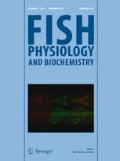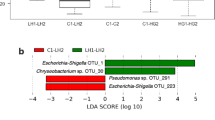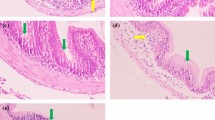Abstract
Hypoxia stress may affect the fish intestine and thereby threaten the growth and survival of the fish. Teprenone is a clinically effective agent in protecting gastrointestinal mucosa. This study aims to assess the effect of teprenone in the intestine of Chinese sea bass Lateolabrax maculatus under intermittent hypoxic stress. L. maculatus juveniles were either raised under intermittent hypoxic condition or normal condition (NC). Part of the hypoxic-intervened fish were treated with teprenone at different concentrations (HTs), and the rest were regarded as hypoxic control (HC). Histological analysis was performed on the epithelial tissue of the fish intestine. High-throughput sequencing technology was used to analyze the diversity and composition of the microbial community in L. maculatus intestine. Reduced villi length and goblet cell, exfoliated enterocyte, and improper arrangement of villi were observed in HC compared with NC and HTs. Proteobacteria, Firmicutes, and Bacteroidetes represented the most abundant phyla in each sample. Significantly higher microbial diversity was detected in HC compared with NC (P < 0.05). At the phylum level, HC presented significantly decreased relative abundance of Proteobacteria, and significantly increased relative abundance of Bacteroidetes, Chloroflex, and Cyanobacteria compared with NC (P < 0.05). At the class level, HC showed significantly reduced relative abundance of Alphaproteobacteria and Bacilli, and significantly increased relative abundance of Clostridia, Gammaproteobacteria, and Bacteroides (P < 0.05). Teprenone protects the intestine from epithelial damages and maintains the microbial harmony in L. maculatus under intermittent hypoxic stress.




Similar content being viewed by others
Change history
10 October 2020
In the end of the Discussion section, following information should be included.
References
Abdallah SJ, Thomas BS, Jonz MG (2015) Aquatic surface respiration and swimming behaviour in adult and developing zebrafish exposed to hypoxia. J Exp Biol 218:1777–1786
Bairagi A, Ghosh KS, Sen SK, Ray AK (2002) Enzyme producing bacterial flora isolated from fish digestive tracts. Aquac Int 10:109–121
Cai YFLL, Zhan WB, Cao HN, Gao P (2006) Effects of chitooligosaccharides on intestinal bacterial flora of juvenile rainbow trout. Periodical of Ocean University of China 36:606–610
Carragher JF, Sumpter JP, Pottinger TG, Pickering AD (1989) The deleterious effects of cortisol implantation on reproductive function in two species of trout, Salmo trutta L. and Salmo gairdneri Richardson. Gen Comp Endocrinol 76:310–321. https://doi.org/10.1016/0016-6480(89)90163-9
Chang ZC, Wen HS, Zhang MZ (2018) Effects of dissolved oxygen levels on oxidative stress response and energy utilization of juvenile Chinese sea bass. J Ocean Univ China:48
Crispo E, Chapman LJ (2010) Geographic variation in phenotypic plasticity in response to dissolved oxygen in an African cichlid fish. J Evol Biol 23:2091–2103. https://doi.org/10.1111/j.1420-9101.2010.02069.x
Foss A, Evensen T, Øiestad V (2002) Effects of hypoxia and hyperoxia on growth and food conversion efficiency in the spotted wolfish Anarhichas minor (Olafsen). Aquac Res 33:437–444. https://doi.org/10.1046/j.1365-2109.2002.00693.x
Jiang ZM, Yu K (2000) Intestinal mucosa injury and intestinal and parenteral nutrition. J Surg Concepts Pract 5:54–56
Kobayashi T, Ohta Y, Yoshino J, Nakazawa S (2001) Teprenone promotes the healing of acetic acid-induced chronic gastric ulcers in rats by inhibiting neutrophil infiltration and lipid peroxidation in ulcerated gastric tissues. Pharmacol Res 43:23–30. https://doi.org/10.1006/phrs.2000.0748
Kormas KA, Meziti A, Mente E, Frentzos A (2014) Dietary differences are reflected on the gut prokaryotic community structure of wild and commercially reared sea bream (Sparus aurata). MicrobiologyOpen 3:718–728. https://doi.org/10.1002/mbo3.202
Larsen AM, Mohammed HH, Arias CR (2014) Characterization of the gut microbiota of three commercially valuable warmwater fish species. J Appl Microbiol 116:1396–1404. https://doi.org/10.1111/jam.12475
Li JZ, Hou J, Zhang PF, Liu YQ, Xia RH, Ma XF (2016a) Comparative study of intestinal microbial community structure in different species of carp in aquaponics system. South China Fisheries Science 12:42–50
Li Y et al (2016b) Oxidative stress, DNA damage and antioxidant enzyme activities in the Pacific white shrimp (Litopenaeus vannamei) when exposed to hypoxia and reoxygenation. Chemosphere 144:234–240. https://doi.org/10.1016/j.chemosphere.2015.08.051
Lima R et al (2011) Survival, growth and metabolic parameters of silver catfish, Rhamdia quelen, juveniles exposed to different waterborne nitrite levels. Neotropical Ichthyology 9:9–152. https://doi.org/10.1590/S1679-62252011005000004
Liu M (2007) Analysis of the microbial community of low oxygen region in Yangtze estuary and Huanghai cold water mass using PCR-DGGE technology high technology. Communication 18:650–652
Lu B, Zhang L, Fan YH, Xu Y (2008) Effects of teprenone on expression of heat shock protein 70 and c-fos in stomach following prednisolone ingestion: experiment with rats. Zhonghua Yi Xue Za Zhi 88:220–224
Ott SJ et al (2004) Reduction in diversity of the colonic mucosa associated bacterial microflora in patients with active inflammatory bowel disease. Gut 53:685–693. https://doi.org/10.1136/gut.2003.025403
Pan YY (2015) Influence of starvation and refeeding on intestinal microbial community in sea bass. Ningbo University
Pickering AD, Pottinger TG (1989) Stress responses and disease resistance in salmonid fish: effects of chronic elevation of plasma cortisol. Fish Physiol Biochem 7:253–258. https://doi.org/10.1007/bf00004714
Pickering AD (1990) Stress and the suppression of somatic growth in teleost fish. Prog Clin Biol Res 342:473–479
Qi XD (2017) Influence of ammonia nitrogen stress on immunity system and microbial composition in crucian. Northwest A&F Universitity
Ramirez R, Dixon B (2003) Enzyme production by obligate intestinal anaerobic bacteria isolated from oscars (Astronotus ocellatus), angelfish (Pterophyllum scalare) and southern flounder (Paralichthys lethostigma). aquaculture 227:417–426. https://doi.org/10.1016/S0044-8486(03)00520-9
Reveco F, Øverland M, Romarheim O, Mydland L (2014) Intestinal bacterial community structure differs between healthy and inflamed intestines in Atlantic salmon (Salmo salar L). Aquaculture 420–421:262–269. https://doi.org/10.1016/j.aquaculture.2013.11.007
Ringø E et al (2015) Effect of dietary components on the gut microbiota of aquatic animals. A never-ending story? Aquac Nutr 22. https://doi.org/10.1111/anu.12346
Shingles A, McKenzie DJ, Claireaux G, Domenici P (2005) Reflex cardioventilatory responses to hypoxia in the flathead gray mullet (Mugil cephalus) and their behavioral modulation by perceived threat of predation and water turbidity. Physiol Biochem Zool 78:744–755. https://doi.org/10.1086/432143
Shirakabe H, Takemoto T, Kobayashi K, Ogoshi K, Kimura K, Nakamura K, Watanabe H (1995) Clinical evaluation of teprenone, a mucosal protective agent, in the treatment of patients with gastric ulcers: a nationwide, multicenter clinical study clinical therapeutics 17:924-935. https://doi.org/10.1016/0149-2918(95)80070-0
Song HX, Weng YZ, Fang QS, Liu ZG, Fang YQ (2008) Studies on the histological changes in gastrointestinal tract of juvenile Epinephelus coioides by starvation. Journal of Oceanography in Taiwan Strait 27:74–78
Sun Y et al (2020) Protection of teprenone against hypoxia and reoxygenation stress in stomach and intestine of Lateolabrax maculatus. Fish Physiol Biochem. https://doi.org/10.1007/s10695-019-00732-4
Terano A, Hiraishi H, Ota S, Sugimoto T (1986) Geranylgeranylacetone, a novel anti-ulcer drug, stimulates mucus synthesis and secretion in rat gastric cultured cells. Digestion 33:206–210. https://doi.org/10.1159/000199296
Van Doan H, Doolgindachbaporn S, Suksri A (2014) Effects of low molecular weight agar and Lactobacillus plantarum on growth performance, immunity, and disease resistance of basa fish (Pangasius bocourti, Sauvage 1880). Fish & shellfish immunology 41:340–345. https://doi.org/10.1016/j.fsi.2014.09.015
Wendelaar Bonga SE (1997) The stress response in fish. Physiol Rev 77:591–625. https://doi.org/10.1152/physrev.1997.77.3.591
Weng YZ, Fang YQ (2011) Effects of starvation on the morphology, localization and distributional density of endocrine cells in the gastrointestinal tract of juvenile Epinephelus coioides. J Oceanography in Taiwan Strait 30:10–16
Wu XF, Zhao QX (2003) A study on adjustion miorobial ecosystem of grass carp with baterial enteritis. J Microbiol 23:23–24
Wu XJ, Chen N, Huang CX, Wang HJ, Wang WM, Wang HL (2016) The effect of hypoxia on myocardial apoptosis in Megalobrama amblycephala. J Huazhong Agricultural University 35:108–113
Xia YJ, Huang WQ, Jiang GL (2000) Histopathology and immunohistochemistry of flounder infected by Vibrio anguillarum. Mar Sci 24:41–44
Xie J, Wang GJ, Deng YS, Yu DG, Wu L, Lu MX (2008) Effects of feeding thermostability enzyme (JM301) on the immunity and microviili lining the gut of tilapia. Fishery modernization 35:27–30
Xu H-x, L-j J, S-n L, T-h Z, Q-l L, Shao Z-z (2016) Diversity of culturable sulfur-oxidizing bacteria in deep-sea hydrothermal vent environments of the South Atlantic. Acta Microbiol Sin 56:88–100
Yang KJ et al (2016) Comparison of the bacterial community structures between healthy and diseased juvenile shrimp (Litopenaeus vannamei) digestive tract. J Fish China 40:1765–1773
Yokogawa K (2000) Morphological and genetic differences between Japanese and Chinese Threeline grunt Parapristipoma trilineatum. Fish genetics and Breed Sci 29:49–60
Yu WN, Dai WF, Tao Z, Xiong JB (2018) Characterizing the compositional and functional structures of intestinal micro-flora between healthy and diseased Litopenaeus vannamei. J Fish China 42:399–409
Author information
Authors and Affiliations
Corresponding author
Additional information
Publisher’s note
Springer Nature remains neutral with regard to jurisdictional claims in published maps and institutional affiliations.
Electronic supplementary material
Fig. S1
Schematic diagram of the modified tank for the detection and management of dissolved oxygen. 1: cultivation tank; 2: nitrogen device; 3: air device; 4: central control unit; 5: input device; 6: warning device; 7: monitoring device; 8: block device; 9: dissolved oxygen probe; 10: water-driving device; 11 and 12: nano-aerator pipe; 13: drain hole. (JPG 28 kb)
Fig. S2
The diagram of experimental setup. NC: fish neither exposed to hypoxic stress nor treated by teprenone; HC: hypoxia-induced fish without teprenone treatment; HT200: hypoxia-exposed fish treated by teprenone at 200 mg/kg; HT400: hypoxia-exposed fish treated by teprenone at 400 mg/kg; HT800: hypoxia-exposed fish treated by teprenone at 800 mg/kg. (JPG 168 kb)
Fig. S3
Rarefaction curve of the samples. NC: fish neither exposed to hypoxic stress nor treated by teprenone; HC: hypoxia-induced fish without teprenone treatment; HT200: hypoxia-exposed fish treated by teprenone at 200 mg/kg; HT400: hypoxia-exposed fish treated by teprenone at 400 mg/kg; HT800: hypoxia-exposed fish treated by teprenone at 800 mg/kg. (JPG 201 kb)
Rights and permissions
About this article
Cite this article
Dong, Hb., Sun, Yx., Duan, Yf. et al. The effect of teprenone on the intestinal morphology and microbial community of Chinese sea bass (Lateolabrax maculatus) under intermittent hypoxic stress. Fish Physiol Biochem 46, 1873–1882 (2020). https://doi.org/10.1007/s10695-020-00838-0
Received:
Accepted:
Published:
Issue Date:
DOI: https://doi.org/10.1007/s10695-020-00838-0




